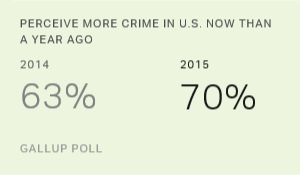Story Highlights
- Blacks less likely than whites, Hispanics and Asians to say home ideal
- Blacks also least likely to say city or area is perfect place for them
WASHINGTON, D.C. -- Blacks are less likely than other major U.S. racial groups to be happy with their homes. Sixty-four percent of blacks agree that their house or apartment is ideal for them and their family, significantly lower than the 75% of whites, 71% of Asians and 70% of Hispanics who say the same.

Regardless of income, blacks are more likely than whites, Asians and Hispanics to disagree that their housing is ideal. This means that income variations alone cannot explain the differences in perceptions of housing among racial and ethnic groups.
These findings are based on interviews conducted from January-November 2015 as part of the . Â鶹´«Ã½AV asked U.S. adults to use a 5-point scale -- where 5 means strongly agree and 1 means strongly disagree -- to rate their level agreement with the following statement: "The house or apartment that you live in is ideal for you and your family." Nationally, 73% of adults agree with this statement, responding with a 4 or 5 on the scale, 13% disagree, responding with a 1 or 2 on the scale, and 15% are neutral, responding with a 3 on the scale.
Blacks Least Likely to See Their City as Perfect Place for Them
Results from a question asking Americans about the city or area where they live show a similar pattern. A majority of U.S. adults across racial and ethnic groups agree that the city or area where they live is a perfect place for them, but blacks (52%) are less likely than whites (64%), Hispanics (67%) and Asians (62%) to agree.

Bottom Line
Housing needs and what qualifies as an "ideal house" can vary widely for each person. Factors such as cost, size, location and neighborhood safety can affect whether individuals feel their house meets their needs. And issues such as access to a safe place to exercise, proximity to quality schools, commute times, the availability of good jobs and access to fresh produce can affect whether an individual feels either their city or their home is right for them. Previous shows that those who see their home as ideal are more likely to have a stronger sense of purpose, a thriving social life, strong ties to their community, financial security and better physical health than those who don't think their home is perfect for them.
Various factors might help explain why blacks have a somewhat less positive view of their homes and communities than other racial groups do. According to the U.S. Census Bureau, blacks are the least likely racial or ethnic group to own their home. aggregated from 2013-2015 also shows that 70% of U.S. whites report owning a home, compared with 41% of blacks and 43% of Hispanics. By renting, these groups have less autonomy to change aspects of their house or apartment to suit their needs.
Further, a study by Johns Hopkins University found that blacks who purchased their first home in the years shortly before the Great Recession have since had a significant loss in their net worth compared with an increase in the net worth of whites who purchased their first home during the same time period. In addition, lagging home prices in minority neighborhoods compared with steady or growing home prices in primarily white or mixed neighborhoods following the recession could be further negatively affecting blacks' views of their cities in general.
Additionally, an investigative report by ProPublica found that judgments on debt collection lawsuits happen almost twice as much in majority black neighborhoods than in mostly white communities, which could potentially influence how blacks from these neighborhoods view their cities or areas.
Despite these factors, a majority of blacks say they live in an ideal home and a perfect city. Increases in black home ownership and other key improvements in majority black communities could help close the racial and ethnic gap in perceptions of housing and communities.
Survey Methods
Results are based on telephone interviews conducted Jan. 1- Nov. 30, 2015, as part of the Â鶹´«Ã½AV-Healthways Well-Being Index survey, with a random sample of 98,533 adults, aged 18 and older, living in all 50 U.S. states and the District of Columbia. For results based on the total sample of national adults, the margin of sampling error is ±0.3 percentage points at the 95% confidence level. For results based on the total sample of 9,061 blacks, the margin of sampling error is ±1 percentage point at the 95% confidence level. All reported margins of sampling error include computed design effects for weighting.
Each sample of national adults includes a minimum quota of 50% cellphone respondents and 50% landline respondents, with additional minimum quotas by time zone within region. Landline and cellular telephone numbers are selected using random-digit-dial methods.
Learn more about how the works.


